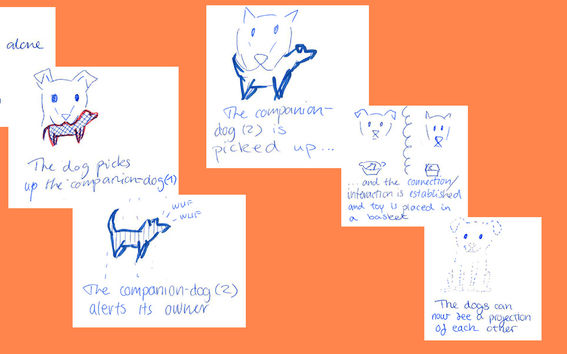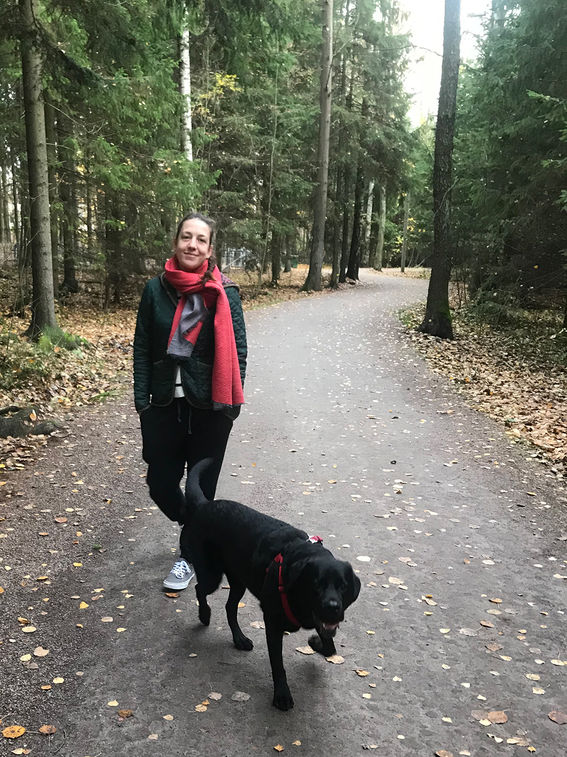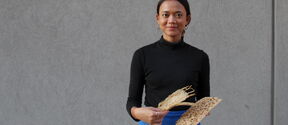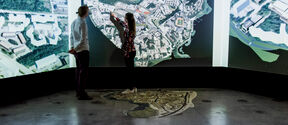Designing an internet for dogs

‘On the Internet, nobody knows you're a dog’ is a meme from the early days of the web. The internet was developed to share information and bring communities separated by geography together, and researchers interested in both animal welfare and machine interfaces are beginning to ask if this can be applied to other animals.
‘A 2018 study of British dogs found that, of the 8.9 million dogs in the UK, 2.1 million were left alone for considerable periods of time. Dogs which are unable to socialise may be more prone to developing negative and problematic behaviours, and the lack of dog-to-dog contact is a major issue in affecting behavioural problems in solitary pet dogs,’ says Dr Ilyena Hirskyj-Douglas, the computer scientist from Aalto University leading the study.
To combat the stresses lonely dogs feel, Dr Hirskyj-Douglas and her colleague, Interaction Design Professor Andrés Lucero from Aalto School of Arts, Design and Architecture, have started exploring dog-computer interfaces to try and focus in on where our gaps in understanding exist, so researchers can solve these problems to develop a doggy internet.
Non-human interaction with computers has been limited to only animal-to-computer or animal-to-human interactions, such as tech to enrich animal enclosures in zoos or things like TV channels for dogs. Dr Hirskyj-Douglas has already researched computer screens controllable by dogs, and is currently extending this research further into dog-to-dog communication.
The Design Ideas
The ideas that make dog-to-dog internet communication possible are intrinsically fun, but the research itself is serious. A team of designers and researchers brainstormed potential devices, and then compared their proposals to see where common challenges lie. The six proposed designs fell into two broad categories, internet connected toys and screen-based devices, where dogs could interact with each other in real time.
Companion-Dog aims to let dogs in different houses play with each other using a dog plush toy. When this toy is picked up, it alerts the other Companion-Dog toy in a friend’s house through a series of ‘woof’ sounds. If the other dog would like to play, he/she also picks up the Companion-Dog toy. This then activates a screen that lets the dogs communicate
Virtual Walk allows the dog to ‘walk’ and ‘run’ with his or her friends whilst in the home. This device is made up on a treadmill which the dog can run/walk on and a screen to see their friends also running/walking at the same time.
When the dog walks up to the screen, it turns on and shows content to the dog. This content is based upon the dog’s behavior, where his/her feedback is collected through his/her tail wags (equivalent of a ‘like’). The dog keyboard has several buttons which allow the manual changing of the content to comedy, food, action, cat videos and nature. This keyboard also has a button to allow the dog to call a friend, who will then also be shown on the TV screen and the content shared allowing joint viewing.
Tangiball allows two dogs to play with balls that remotely move the same whilst seeing holograms of one another. For example, this allows one dog in their home to pick up Tangiball and throw it, throwing the Tangiball in the second dogs home. As a result, this allows two dogs to play with each other in a way that simulates two dogs playing with a ball at the park.
Dogs like ‘tug-of-war’ games with ropes. When the first dog interacts with the technology a notification will be sent to the second dog by wiggling the rope in the second dogs home alerting the dog that his/her friend wants to play. Once both dogs have ‘bitten down’ on the rope the tug of war game begins. The strength of the ‘tug’ from each dog is sent through the rope to allow for long distance interaction with the tangible rope object.
This idea allows neighbouring dogs to organise to meet each other. If one dog wants to meet another dog, a laser guides them leading to a nearby fence. The other dog’s collar shines a laser on the floor which guides the dog to the fence.

The conclusion from the design session is that for the dog internet to progress, further research would be needed to turn specific dog behaviours into inputs that machines can then use to transmit to, and be understood by, other dogs. 'Understanding what is being “said” by the dog to the technology and understanding the relationship between the dog and other actors is core,’ says Dr Hirskyj-Douglas.
The results of the work are being presented at the CHI 2019 conference in Glasgow. The team hope that the ideas raised will help guide the field towards developing tech for animals to connect to one other.
Further details:
Contact details:
Dr Ilyena Hirskyj-Douglas
https://ilyenahirskyjdouglas.wordpress.com/
ilyena.hirskyj-douglas@aalto.fi
Professor Andrés Lucero
andres.lucero@aalto.fi
Read more news

From award-winning food packaging to researching biodesign spaces
From an early age, Ena Naito was drawn to both the sciences and design. She found the perfect place to bring those two worlds together.
Architect and designer Talisa Dwiyani combines passion, materials, and collaboration in her work
Indonesia-born Talisa's takeaway from Aalto University is the cross-disciplinary way of working.
Giiguulen Enkhsaikhan: More sustainable textiles with hemicellulose
Aalto University's doctoral researcher's presentation of hemicellulose won the third prize in the Marcus Wallenberg Young Researchers’ Challenge event in November






